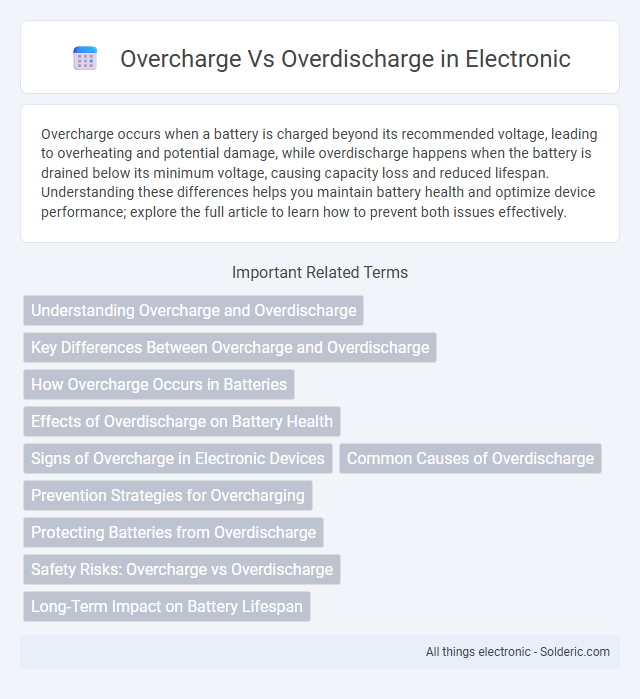Overcharge occurs when a battery is charged beyond its recommended voltage, leading to overheating and potential damage, while overdischarge happens when the battery is drained below its minimum voltage, causing capacity loss and reduced lifespan. Understanding these differences helps you maintain battery health and optimize device performance; explore the full article to learn how to prevent both issues effectively.
Comparison Table
| Aspect | Overcharge | Overdischarge |
|---|---|---|
| Definition | Charging a battery beyond its maximum voltage limit. | Discharging a battery below its minimum voltage threshold. |
| Voltage Effect | Exceeds upper voltage limit (e.g., >4.2V for Li-ion cells). | Drops below lower voltage limit (e.g., <2.5V for Li-ion cells). |
| Battery Chemistry Impact | Causes electrolyte breakdown and electrode damage. | Leads to irreversible electrode degradation and capacity loss. |
| Safety Risks | Risk of thermal runaway, fire, explosion. | Potential cell reversal and internal short circuits. |
| Performance Impact | Reduces cycle life and capacity retention. | Decreases capacity and cycle life significantly. |
| Protection Methods | Battery Management Systems (BMS), voltage cut-off circuits. | Low-voltage cut-off, BMS, state-of-charge monitoring. |
| Common in | Improper chargers, absence of BMS. | Deep discharging, excessive load, faulty BMS. |
Understanding Overcharge and Overdischarge
Overcharge occurs when a battery receives more voltage or current than its specified maximum limit, causing internal damage and reducing battery lifespan. Overdischarge happens when a battery's voltage drops below its safe threshold, leading to capacity loss and potential cell failure. Understanding these conditions helps you maintain battery health and ensures optimal performance and safety.
Key Differences Between Overcharge and Overdischarge
Overcharge occurs when a battery receives a voltage or current exceeding its specified limit, causing heat buildup, reduced capacity, and potential safety hazards like swelling or explosion. Overdischarge happens when a battery is drained below its minimum voltage threshold, leading to diminished capacity, internal damage, and shortened lifespan. The key difference lies in overcharge involving excessive energy input, while overdischarge results from excessive energy extraction, both critically affecting battery performance and safety.
How Overcharge Occurs in Batteries
Overcharge occurs in batteries when the charging voltage exceeds the battery's recommended maximum voltage limit, causing excessive current to flow into the battery cells. This leads to increased internal pressure, heat generation, and potential damage to the electrolyte and electrode materials, reducing battery lifespan and safety. Common causes include malfunctioning chargers, incompatible charging protocols, or extended charging times beyond the full capacity threshold.
Effects of Overdischarge on Battery Health
Overdischarge can cause severe damage to your battery's health by leading to voltage dropping below safe thresholds, which triggers irreversible chemical changes and capacity loss. This condition reduces the battery's overall lifespan, increases internal resistance, and may cause safety hazards such as swelling or leaks. Proper battery management systems are essential to prevent overdischarge and maintain optimal battery performance.
Signs of Overcharge in Electronic Devices
Signs of overcharge in electronic devices include excessive heat generation, swelling or bulging of the battery, and rapid battery drain despite being plugged in. Users may also notice slower device performance, unexpected shutdowns, or error messages indicating battery issues. These symptoms often signal that the device's charging circuitry is failing to stop power flow, risking permanent battery damage or safety hazards.
Common Causes of Overdischarge
Overdischarge commonly occurs due to prolonged use without timely recharging, leading to battery voltage dropping below the safe threshold. Faulty battery management systems (BMS) or improper charger settings can also cause overdischarge by failing to cut off power when the battery reaches critical levels. Environmental factors such as extreme temperatures accelerate capacity loss, increasing the risk of severe overdischarge damage.
Prevention Strategies for Overcharging
Preventing overcharging in lithium-ion batteries involves using smart battery management systems equipped with voltage sensors and automatic cutoff mechanisms that stop charging once the cell reaches its maximum voltage threshold, typically around 4.2 volts. High-quality chargers with built-in overcharge protection and temperature monitoring significantly reduce the risk by adjusting charging current according to battery status and ambient conditions. Regular calibration of the battery management system and using certified charging equipment further enhance safety and prolong battery lifespan by avoiding excessive voltage stress.
Protecting Batteries from Overdischarge
Protecting batteries from overdischarge is crucial to maintain their lifespan and efficiency. Overdischarge occurs when the battery voltage drops below a critical threshold, causing irreversible damage to the battery's cells and reducing its capacity. Using battery management systems (BMS) and voltage cutoff devices helps you avoid deep discharge, ensuring safe operation and prolonging the overall battery performance.
Safety Risks: Overcharge vs Overdischarge
Overcharging lithium-ion batteries causes excessive heat generation, increasing the risk of thermal runaway, fires, and explosions due to electrolyte decomposition and internal short circuits. Overdischarging reduces the battery voltage below safe thresholds, leading to irreversible capacity loss, potential internal copper dissolution, and increased risk of short circuits when recharged. Both conditions compromise battery safety but present distinct hazards: overcharge primarily triggers thermal events, while overdischarge results in structural damage and potential electrical failures.
Long-Term Impact on Battery Lifespan
Overcharging lithium-ion batteries causes excessive heat and accelerates electrolyte decomposition, significantly reducing battery lifespan by promoting capacity loss and swelling. Overdischarging leads to electrode degradation and copper dissolution, resulting in permanent capacity loss and increased internal resistance. Both conditions compromise battery safety and performance, emphasizing the importance of maintaining voltage within manufacturer-recommended limits for long-term durability.
Overcharge vs Overdischarge Infographic

 solderic.com
solderic.com